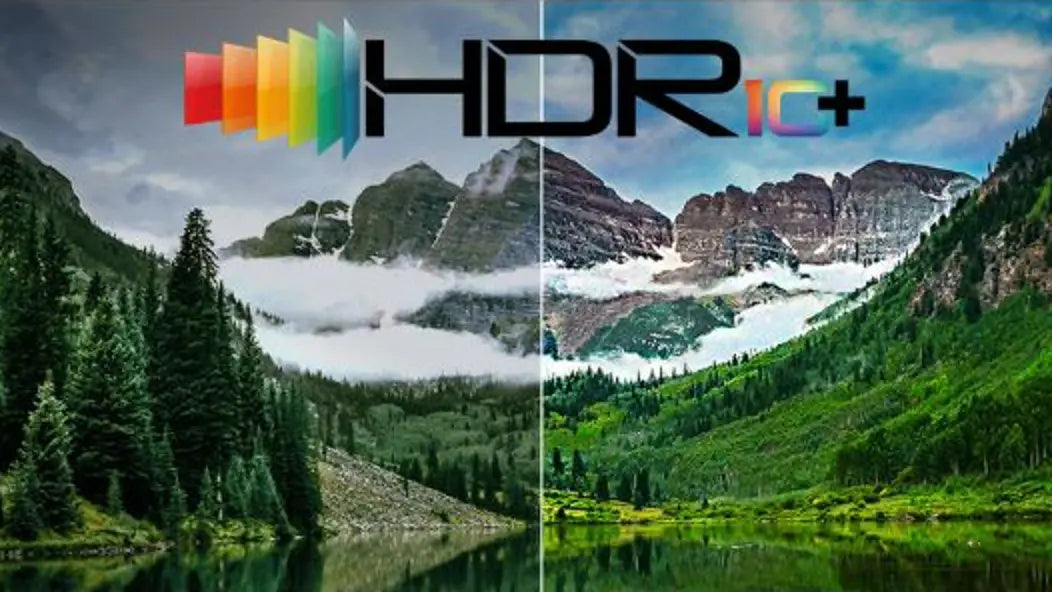Table of Contents
What is HDR10+ and How Does it Work?

High Dynamic Range (HDR) technology has become a must-have feature for TVs today, providing more vibrant and realistic colours, greater contrast, and a brighter image.
However, not all HDR formats are created equal, and one of the most advanced HDR formats available today is HDR10+.
In this article, we'll explore in-depth what HDR10+ is, how it works, and why it's a valuable feature to consider when purchasing a new TV for your home.
What is HDR10+?
HDR10+ is an open standard format that has been developed by some of the industry's leading technology companies.
HDR10+ is primarily used for enhancing the image quality of video content. It allows content creators and distributors to deliver high-quality HDR video with improved colour accuracy, contrast, and brightness.
This format is an enhancement of the HDR10 format and builds upon its foundation. HDR10+ adds dynamic metadata, which enables the TV to adjust the brightness and contrast levels dynamically, frame-by-frame, or even scene-by-scene, ensuring that you see the content the way it was meant to be seen by the filmmaker.

Dynamic Metadata
Dynamic metadata is the key differentiator between HDR10+ and other HDR formats.
In traditional HDR formats, the metadata is static and applies the same adjustments to the entire video. With HDR10+, the metadata changes with every frame, ensuring the best possible image quality.
This dynamic adjustment of brightness and contrast levels allows the TV to display more nuanced details in both bright and dark areas of the screen, providing a more realistic and immersive viewing experience.

Benefits of HDR10+
One of the main benefits of HDR10+ is its ability to display more accurate and vibrant colours. This is because it supports a wider colour gamut and a higher colour depth than other HDR formats.
HDR10+ supports up to 10-bit colour depth, allowing for over a billion different colours, which ensures that the colours you see on your TV are more true to life.
Additionally, HDR10+ also supports a higher peak brightness level, allowing you to see more details in the brightest areas of the image.
How to Experience HDR10+?
To take full advantage of HDR10+ on your TV, you need a TV that supports the format. Fortunately, PRISM+ offers a range of 4K TVs that support HDR10+.
If you choose HDR10+ TV like the Q65 Ultra, you can experience HDR10+ content the way it was meant to be seen.
HDR10+ is becoming more prevalent, with a growing number of movie studios and TV networks using it as their primary HDR format. Amazon Prime Video, for example, uses HDR10+ for all of its HDR content.
Many Hollywood studios, including 20th Century Fox, Warner Bros., and Universal Pictures, have also announced that they will be releasing movies in HDR10+. This means that the amount of HDR10+ content available is only going to grow.
Other HDR Formats
Another HDR format that is worth mentioning is Dolby Vision. Like HDR10+, it adds dynamic metadata to adjust the image on a frame-by-frame basis for a more accurate and immersive viewing experience.
It also supports a higher maximum brightness level than HDR10+, which means it can produce an even more striking image in certain scenes.
Some TVs support both HDR10+ and Dolby Vision, like the Ultra 55 and Ultra 65, providing the best of both worlds for viewers who want the most advanced HDR technology available.

Want to know more about Dolby Vision? Read this: What is Dolby Vision and Dolby Atmos? - A Must-Have For a Home Cinema
So Should I Get an HDR10+ TV?
In conclusion, HDR10+ is an advanced HDR format that offers significant improvements in image quality over other standard HDR formats.
By using dynamic metadata to adjust the colour and brightness levels, HDR10+ provides a more precise and vibrant image quality that enhances your TV viewing experience.
With HDR10+ becoming more prevalent, we definitely recommend you invest in a PRISM+ TV that supports HDR10+ to ensure that you're future-proofing your entertainment experience.
FAQs
|
What devices support HDR10+? HDR10+ is supported by a range of TVs from manufacturers like Samsung, Panasonic, and PRISM+. Additionally, certain Blu-ray players, streaming devices, and game consoles are also compatible with HDR10+. Can I watch HDR10+ content on a non-HDR10+ TV? While non-HDR10+ TVs can display HDR10+ content, they won't fully benefit from the dynamic metadata. However, HDR10+ content is often backward compatible with HDR10, ensuring a reasonable HDR experience on non-HDR10+ TVs. Is HDR10+ better than Dolby Vision? HDR10+ and Dolby Vision are both excellent HDR formats, each with its own strengths. Dolby Vision is widely supported and known for its exceptional quality, while HDR10+ offers scene-by-scene optimization and is more accessible across various devices. Can I convert HDR10 content to HDR10+? Converting HDR10 content to HDR10+ is technically possible, but it requires the content to be re-encoded with dynamic metadata. Currently, there are limited options for converting HDR10 to HDR10+. Is HDR10+ only available for streaming content? No, HDR10+ is available for both streaming content and physical media. Streaming platforms like Amazon Prime Video and certain Ultra HD Blu-rays offer HDR10+ content for an enhanced viewing experience. |


